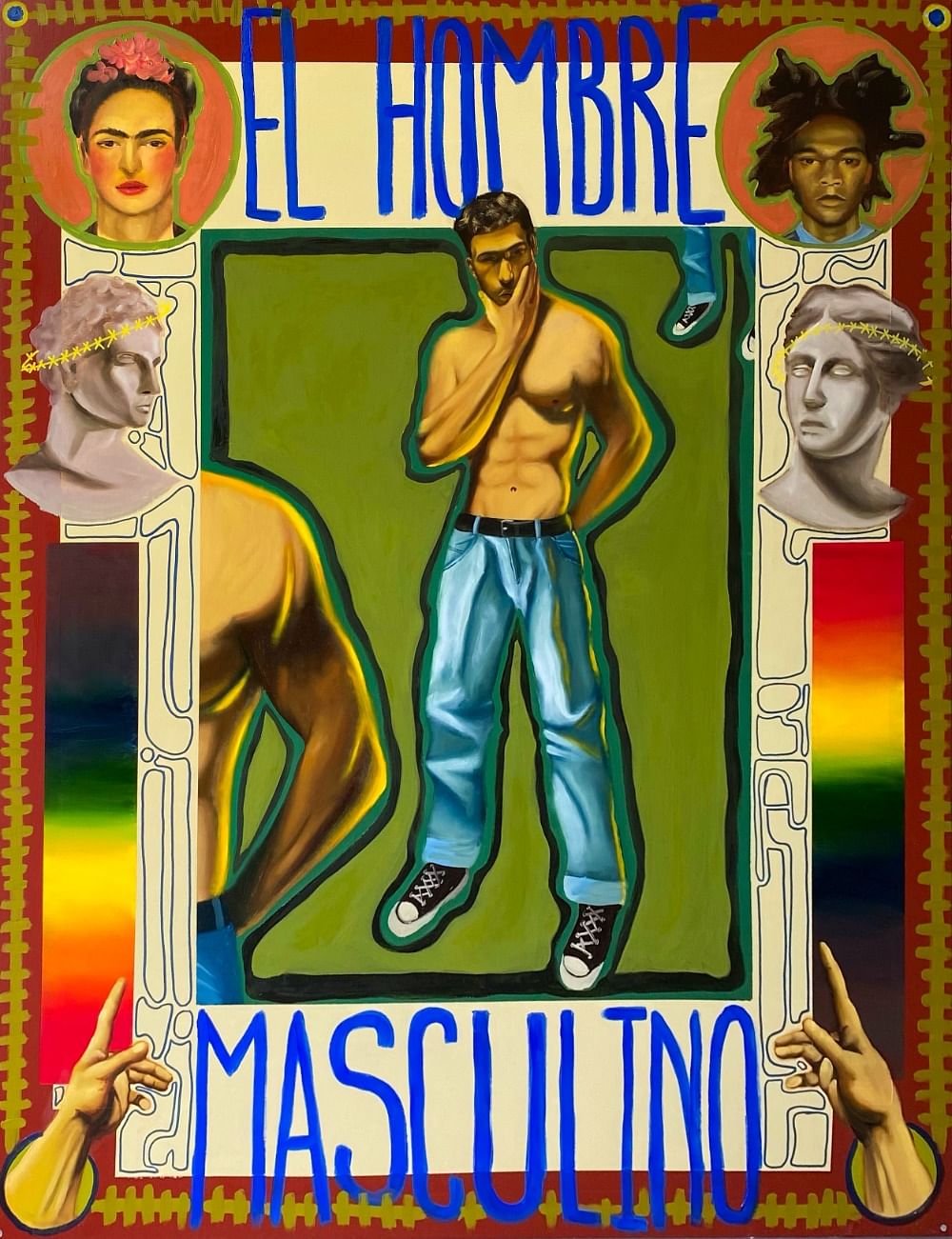A new generation of young artists in Singapore is exploring and dissecting masculinity with inclusivity and tenderness.
AADITYA SUNDAR
Last month, this fashion and fine art photographer, debuted Can You Show Me Your Drawer Of Drawers? – a 266-page photography book produced in collaboration with freelance creative/stylist Nicholas See – at Singapore Art Book Fair.
Long-time friends who are in their early 20s, the duo had spent a year capturing 15 individuals – some friends; others strangers found through social media – for the self-published work, with Aaditya behind the camera and See on creative direction.

Aaditya Sundar
Throughout the publication, the subjects are seen in various states of undress (all had provided consent to be photographed this way) – the idea was to explore the different facets of masculinity through the bodies of young Singapore males not unlike the book’s creators themselves.

Says Aaditya, “It was important that the images present the male body beyond how it’s normally portrayed in the media.” It explains the diversity of body types represented, as well as the choice of each subject’s home for the setting. One picture, for instance, depicts a tattooed male resting in a child’s pose on his bed with a fuzzy teddy bear perched on his back.
There’s another of a youth doing a headstand on his living room couch while his mother sits beside him, smoking away nonchalantly. Contrasting these snapshots of irreverent yet tender moments in one’s everyday life are those of a more poetic and enigmatic nature, such as that of a pair of legs dressed in fishnet stockings criss-crossed on a bed. Overall, it’s a uniquely intimate, unguarded look at the inner lives of men here.
“Through working on this project, I had the opportunity to talk to so many people of different classes, races and sexualities on their idea of masculinity,” says Aaditya. “I think the beauty of the perception of masculinity now is that it’s ever-changing – something that is only formed by life experiences and is unique to each individual.”
See it for yourself – Can You Show Me Your Drawer Of Drawers? is available for pre-order via DM on Aaditya’s and See’s personal Instagram accounts (@moonpiercer and @mystrangeanarchy respectively).
It explains the diversity of body types represented, as well as the choice of each subject’s home for the setting. One picture, for instance, depicts a tattooed male resting in a child’s pose on his bed with a fuzzy teddy bear perched on his back.
There’s another of a youth doing a headstand on his living room couch while his mother sits beside him, smoking away nonchalantly. Contrasting these snapshots of irreverent yet tender moments in one’s everyday life are those of a more poetic and enigmatic nature, such as that of a pair of legs dressed in fishnet stockings criss-crossed on a bed. Overall, it’s a uniquely intimate, unguarded look at the inner lives of men here.
“Through working on this project, I had the opportunity to talk to so many people of different classes, races and sexualities on their idea of masculinity,” says Aaditya. “I think the beauty of the perception of masculinity now is that it’s ever-changing – something that is only formed by life experiences and is unique to each individual.”
See it for yourself – Can You Show Me Your Drawer Of Drawers? is available for pre-order via DM on Aaditya’s and See’s personal Instagram accounts (@moonpiercer and @mystrangeanarchy respectively).
EDWIN CHEN
This 25-year-old visual artist basks in his world of lush ink drawings (view them at @drawwins) and it’s not simply because they’re often self-portraits. “It’s difficult to explain how my works interpret masculinity through words without falling back on clear and traditional demarcations and labels,” he says.
“The visual world feels (more) liberating (compared to text) because it doesn’t rely on defining what masculinity and femininity mean. More things become possible in this open and murky space,” he says.

Edwin Chen
Indeed his expansive images feature the likes of human figures luxuriating in richly detailed, surrealist jungles where delightful surprises await those who examine closely. Eyeballs peek out from amidst the flora and fauna, for example, while his subjects possess a fantastic, otherworldly quality with appendages spanning tentacles to wings.
For Chen, his art is a safe harbour where anxieties over what constitutes the perfect body are banished or transformed into something transcendental, which also explains why the character he dreams up are often unclothed. Besides providing a striking visual contrast to the environments they’re situated in, stripping his subjects removes the loaded symbols and associations that can come with clothes.

Another of Chen’s key motifs: mythicism – not only because he admires the elaborate designs and beauty of its icons, but also because he sees it as a way through which he can understand and piece together his own reality. “Another reason why I keep returning to deities and sanctums in my work is because I’m constantly asking existential questions… When I draw, our big, ridiculous universe becomes a little less terrifying,” he says.
“To think of me as an artist who draws erotic images is a fundamental misunderstanding of my practice,” he says. “Rather, I treat the human body as a fluid symbol. It’s a vessel to explore spirituality and to lay bare some truth about what it means to be human.”
ELDEN ZACHERY
Pain, confusion and anger are understandably common threads in queer narratives. Yet this emerging fashion designer (@eldenzachery) – who goes by the he/they pronoun – prefers to use their work to uplift and empower.

Elden Zachery
Enter Limp Wrist, their powerfully visceral graduate collection that was revealed in March as part of their final year project at Temasek Polytechnic’s School of Design, and chronicles their personal experiences and emotions built up over the years.

A deconstructed vest made up of scalloped discs of fabric and adorned with skeins of hair is an allusion to Zachery’s first expression of femininity as a child when they played with their mother’s hair.
Photography Aaditya Sundar Styling & Makeup Elden Zachery, assisted by Samantha Chan & Rebecca Pinto
For example, a deconstructed vest made up of scalloped discs of fabric and adorned with skeins of hair is an allusion to Zachery’s first expression of femininity as a child when they played with their mother’s hair.
This fascination with hair reappears in the fashion film that accompanies the project – viewable here – and depicts current-age Zachery tenderly braiding their mother’s locks.
“I’m more interested in creating a story of queer triumph because I’m tired of queer tragedy and struggle,” they explain. “My journey has been tough and yes, this is reflected in my work, but I don’t like to see or portray my queerness as a struggle. I never want to see it that way again. It has been more a blessing than anything.”
Limp Wrist is also an embodiment of their aspirations, with a bridal finale look (a chained vest and trouser pairing that comes with a sequinned veil) representing a future that they hope for. That Zachery is the model throughout the lookbook drives home the message that this artful collection is more a project for themselves than anything else.
“My goal was to use my collection to document my personal experiences and that it would be something that a 50-yearold me can look back on and reminisce…,” says Zachery. “Masculinity used to be something that I was sorry for not having enough of, but I also felt the same way about femininity. I have just never felt fully at home with either.. Now I prefer to flourish in this and shake whatever table I need to shake.”
TAUFIQ RAHMAN
This 29-year-old visual artist‘s photography often depict men in various states of undress amidst grass patches, the bowels of industrial buildings and other quotidian settings. The subjects come across as people one might meet on the streets – young men garbed in the likes of a Nike tank top, or puffer jacket and track pants.

Taufiq Rahman
The starting point of his images is usually his own lived experiences, says Taufiq. Growing up was not an easy time, especially with his petite build (he’s 1.64m tall). “I was a lot more flamboyant than I am now so people thought it cute to dress me up. I thought it was normal for boys to play dress up. That wasn’t the case though and I’ve felt like an outsider ever since.”

It’s why in his work today, he deliberately flits within the amorphous space that sits between what’s right and wrong. His subjects are often unclothed or semi-dressed because it’s his way of responding to his rigid upbringing. “Growing up, I was so engineered to stay in the shadows so this idea of going against the norm and showcasing the male body feels liberating for me.”
Even his favoured approach to image-making – informal and on-the-fly – is what some might consider unorthodox. And, yes, if you’re wondering, he’s completely self-taught. “I document what I have access to,” he says plainly.
For what it’s worth though, there’s an unmistakable and beguiling sense of tenderness that shines through his pictures, making him one of the most exciting photographers to emerge here in recent years.
ISRAFIL RIDHWAN
There’s something about this 22-year-old‘s oil paintings that brings to mind old-world movie posters – the kind that used to be hand-painted and have arguably become an art form in itself. Every one depicts a scene that looks right out of a classic film (think men getting their hair shorn at the barber’s), brought to life through Israfil’s signature use of chiaroscuro and a warm, rich colour palette.

Israfil Ridhwan
For one thing, he credits a love for “cinematic” songs and musical genre (his go-to aristes include Lana Del Rey, Bad Bunny, and Rosalia) as playing a major role in his art-making. Then there’s the most central element in his works: his depiction of men as muscular and moustachioed – not unlike the gruff, macho leads of the silver screen from a time past.
Israfil professes to be a “traditional romantic” at heart and wants the figures in his paintings to “flirt with the viewers”. This is apparent in their expression – sensual looks of desire – and peak physicality.

(The artist lets on that the chiselled statues of traditional Greek gods and goddesses were what had sparked his interest in art.) Beyond inducing nostalgia though, his representation of the male form stems from insecurities about his own body.
“You see, I’m this skinny guy who’s always wanted a nice body,” he says. “I’m always uncomfortable in my own skin and always thinking, ‘What do people think of me? If only I were fitter.”
Coupled with his art’s incorporation of pop culture icons – the visage of his favourite artist Frida Kahlo; a bottle of Tom Ford perfume, to name a few – and he’s become one of the most buzzed-about young names among collectors here. (His debut solo show, The Divine Comedy, held at Cuturi Gallery last July, sold out.)
“I love the idea of a masculine man and a feminine woman. There’s a certain beauty in it,” says Israfil. “I’d like to say that I’m a guy who’s a little in touch with my feminine side and I don’t think that there’s anything wrong with that.”
A version of this article will appear in the June 2022 Male Edit issue of FEMALE.

